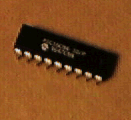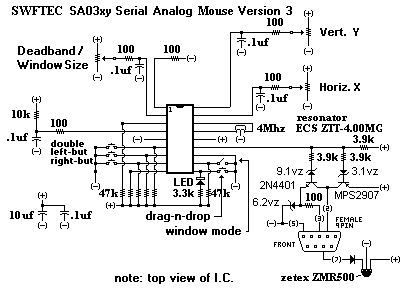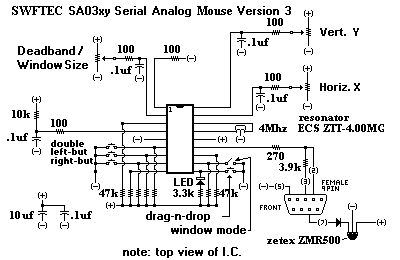
SA03xy Serial Analog Input Mouse Controller
 | 
|
| Integrated Circuit | Typical Application Circuit Diagram - I.C. Top View |
The SA03xy Serial Analog Input Mouse Controller is compatible with the standard Microsoft Mouse Drivers or any Drivers that are Microsoft Mouse compatible. It uses analog voltage levels to control mouse cursor movement instead of the usual optical encoder inputs. This makes it easy to use the controller to build special devices to enable handicapped or disabled people to control their computer mouse functions. It is also easy to use it to build special mouse controllers for use in computer applications where a standard mouse would not work such as industrial environments. This I.C. has been used mostly with joysticks. These have been both standard potentiometer type and hall effect type joysticks. Of course any voltage source can be used. This would include, accelerometers for tilt sensing, solid state gyros for rotation sensing and photosensors for light sensing and various devices like Koala pads to name a few. The analog voltage inputs control the mouse cursor motion, direction and speed. The analog inputs have a range of 0 to 5 volts. The zero motion value is 2.5 volts with an adjustable deadband. The deadband is a fixed value of 15% of range above 2.3 volts on the deadband input. It varies from 0 to 50% of range from 0 to 1.25 volts (+/- 25% of 5 volts). The I.C.s are available with a selection of motion direction. For example the SA03RD moves the cursor Right on a voltage higher than the deadband on the X axis and Down on a voltage higher than the deadband on the Y axis. Below the deadband zone the cursor moves in the opposite direction. Cursor speed is proportional to the deviation from the deadband. Typically the cursor can cross the screen in less than 1 second at full deviation. The SA03xy has a unique sliding window mode thats selected with pin 11. When pin 11 is held low the deadband function becomes the sliding window function. The deadband input sets the window size. Within the "window" the cursor movement is proportional to the voltage change on the analog inputs. The positioning is more like absolute positioning. For example on a joystick if you move the stick a little to the left the cursor moves a little to the left. The cursor stops moving if the joystick stops moving. If the joystick is moved beyond the "window" zone the cursor movement reverts to the relative mode and it "slides" at a speed proportional to the deviation from the window. The effect is that the absolute positioning window can be slid around to any area of the screen no matter the size or resolution. The "window" typically can be as much as 4 inches square depending on the deadband/window size input voltage. This version Serial Mouse controller currently doesn't support the Wheel Mouse 3D modes. There is no Z Axis. The switch inputs provide: LEFT BUTTON DOUBLE-CLICK, LEFT BUTTON, RIGHT BUTTON , DRAG-N-DROP and WINDOW MODE SELECT. The DRAG-N-DROP input effectively locks down the left button for a drag operation. Activating any button input or the DRAG-N-DROP input a second time releases the left button and ends the drag operation. The optional LED (Light Emitting Diode) shown in the DRAG-N-DROP pull-up lights during the drag and drop operation. The Serial Mouse has a polarity input on pin 12 which selects the polarity of the serial output on pin 13. This allows using non-inverting or inverting buffers or no buffer at all. Below is the typical "minimal parts" no buffer circuit diagram. Note that this circuit may not work with all computers. This depends on the RS232 buffers used in the PC.

The switches are wired with a common negative (pull down to activate). External circuitry can also be used in place of switches so the mouse controller can be controlled by another device (i.e. another microcontroller, photosensors etc...). Note that the DRAG-N-DROP pin 10 is both an input and an output. When interfacing pin 10 to external circuitry there should be no active pull-up. The I.C. is available in a version without the LED option so pin 10 is always an input and active high circuitry can used. Otherwise a open collector can be used for interface. The price of the Serial Analog Input Mouse Controller I.C. is $20.00. Quantity pricing is available.
Click here to E-Mail swftec@aol.com for more info, comments or request
Click here to return to Main Page or click BACK on your Browser.